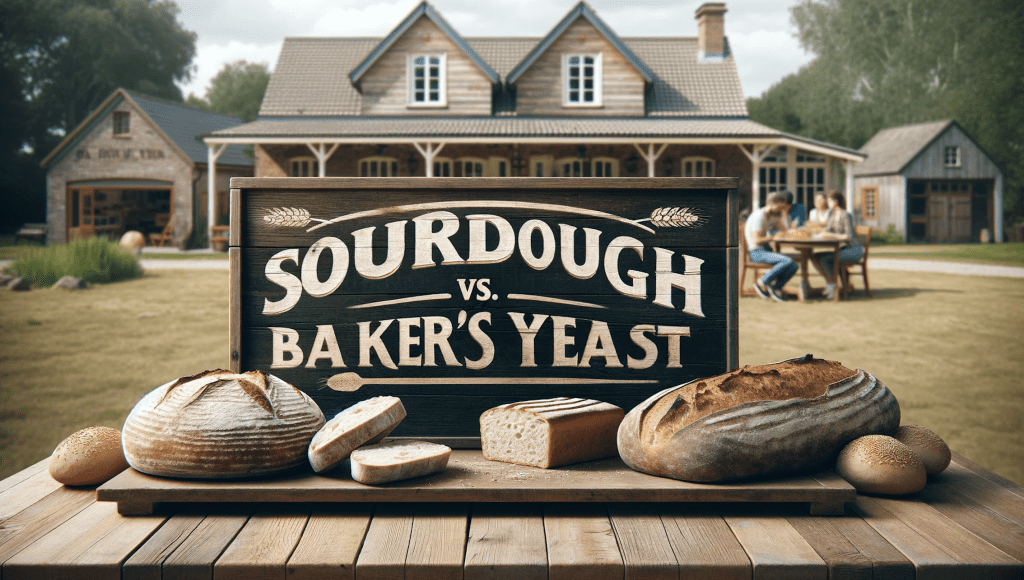In the realm of bread-making, two primary methods have stood the test of time: sourdough bread and baker’s yeast based bread. Each method offers unique characteristics, influenced by the choice of leavening agent. This article aims to provide a technical and historical overview of these methods, exploring their differences, the reasons behind the invention of baker’s yeast, and the implications for taste, health, and nutrition.
What is Sourdough Bread?
Sourdough bread is the result of a centuries-old technique that leverages a natural leavening process. The key to sourdough is the starter, a mixture of flour and water that has been allowed to ferment naturally. This fermentation is driven by wild yeasts and lactic acid bacteria present in the environment, which break down the starches and sugars in the flour, producing carbon dioxide and organic acids. The organic acids give sourdough its distinctive tangy flavor and contribute to its longer shelf life compared to breads made with baker’s yeast.
What is Baker’s Yeast Bread?
Baker’s yeast bread utilizes a commercially produced strain of yeast, Saccharomyces cerevisiae, as its leavening agent. This yeast ferments the sugars in the dough rapidly, producing carbon dioxide and alcohol. The carbon dioxide gas creates air pockets in the dough, causing it to rise. Baker’s yeast provides a more controlled and predictable fermentation process compared to sourdough, resulting in a softer texture and milder flavor.
Differences Between Sourdough and Baker’s Yeast Bread
The primary differences between sourdough and baker’s yeast bread are rooted in their leavening agents, fermentation processes, flavor profiles, nutritional differences, shelf life, and baking techniques:
- Leavening Agents: Sourdough bread is leavened using a natural starter that contains a mix of wild yeast and lactic acid bacteria, whereas baker’s yeast bread relies on commercially produced Saccharomyces cerevisiae for leavening.
- Fermentation Process: Sourdough undergoes a slow fermentation process, taking hours to days, allowing for the development of complex flavors and textures. In contrast, baker’s yeast bread ferments more quickly, typically within a few hours, resulting in a more uniform crumb structure.
- Flavor Profiles: Sourdough bread is known for its tangy taste and chewy texture, attributed to the lactic acid produced during fermentation. Baker’s yeast bread has a milder, sweeter flavor and a softer crumb.
- Nutritional Differences: Sourdough bread may offer slightly better nutritional benefits, as the fermentation process can reduce phytic acid levels and increase mineral availability. It might also be easier to digest due to the breakdown of gluten during fermentation.
- Shelf Life: Sourdough bread generally has a longer shelf life than baker’s yeast bread, as the acidic environment created by sourdough fermentation helps inhibit mold growth.
- Crust and Crumb: Sourdough bread often features a thicker, more robust crust, while baker’s yeast bread typically has a softer crust. The crumb of sourdough can vary from open and airy to dense and chewy, depending on various factors like hydration and fermentation time.
- Baking Techniques: The techniques used in sourdough baking, such as autolyse, stretch and fold, and bulk fermentation, differ from those used in baking with baker’s yeast, contributing to the unique characteristics of sourdough bread.
These differences highlight the unique qualities of sourdough and baker’s yeast bread, offering a range of options for bakers and consumers to explore and enjoy.
Quality Subtleties Between the Two
Sourdough enthusiasts often appreciate the bread’s depth of flavor, which can range from mildly tangy to distinctly sour, depending on the fermentation time and temperature. The presence of lactic acid bacteria in sourdough also contributes to a slightly acidic environment, which can improve the bread’s texture and nutritional profile. On the other hand, baker’s yeast bread is often praised for its uniformity and consistency, making it a versatile choice for various culinary applications.
The Invention of Baker’s Yeast: Historical Context and Impact
The development of baker’s yeast, specifically Saccharomyces cerevisiae, in the 19th century marked a significant turning point in the history of bread-making, driven by the rapid urbanization and industrialization of the era. The origins of commercial yeast can be traced back to the early 1800s, with notable advancements made by scientists such as French microbiologist Louis Pasteur. Pasteur’s research in the 1850s and 1860s on fermentation and the role of yeast in alcohol production laid the groundwork for understanding yeast’s leavening properties. In 1857, he conclusively demonstrated that yeast was a living organism responsible for fermentation, debunking the prevailing theory of spontaneous generation.
The first commercial production of baker’s yeast began in Germany in the 1820s, with significant contributions from distillers and bakers in the region. However, it was not until the latter half of the 19th century that the production of compressed yeast became industrialized, particularly in Europe and North America. This period saw a surge in urban populations, creating a demand for quicker and more reliable methods of bread production. The traditional sourdough process, which required a longer fermentation time, was ill-suited to the fast-paced urban lifestyle and the growing need for consistent and scalable food production.
The industrial revolution played a crucial role in the widespread adoption of baker’s yeast. Advances in technology and transportation, such as the steam engine and the expansion of railway networks, facilitated the mass production and distribution of yeast and bread. The establishment of large-scale bakeries and the mechanization of bread-making processes further accelerated the transition from artisanal sourdough to yeast-leavened bread.
By the late 19th and early 20th centuries, baker’s yeast had become an integral part of the baking industry, transforming the way bread was produced and consumed. The ability to produce bread in large quantities with uniform quality and a predictable rise time revolutionized the industry, making bread more accessible to the growing urban populations. The economic and geopolitical shifts of the time, including the expansion of trade networks and the rise of factory-based production, played a significant role in the widespread adoption of baker’s yeast, cementing its place as a cornerstone of modern bread-making.
Adoption and Impact on Sourdough Culture
The introduction of baker’s yeast marked a decline in traditional sourdough baking, as the faster and more predictable method gained popularity. However, sourdough has experienced a resurgence in recent years, driven by a growing appreciation for artisanal foods and an interest in the health benefits of fermented products.
Health, Nutrition, and Taste Differences
Sourdough bread is often considered healthier than its baker’s yeast counterpart. The fermentation process in sourdough can reduce the bread’s glycemic index, making it less likely to cause spikes in blood sugar levels. Additionally, sourdough fermentation can increase the availability of certain nutrients and reduce the presence of antinutrients. In terms of taste, sourdough offers a more complex flavor profile, which can enhance the overall eating experience.
Baker’s Yeast: A Complementary Approach, Not a Replacement
While baker’s yeast has become the standard in modern bread-making, it was never meant to completely replace sourdough. Each method has its place in the culinary world, and the choice between them depends on the desired characteristics of the final product. Baker’s yeast offers speed and consistency, while sourdough provides depth of flavor and potential health benefits.
Sourdough’s Timeless Appeal
Despite the dominance of baker’s yeast, sourdough has remained a beloved tradition in many cultures. Its enduring appeal lies in its simplicity and the unique flavors it brings to bread. The recent revival of sourdough reflects a broader trend towards valuing traditional food practices and seeking out more authentic and nutritious options.
Advice for Novice Bakers
For those new to baking, experimenting with a combination of sourdough and baker’s yeast can be a helpful way to achieve consistent results while exploring the nuances of sourdough. This approach allows bakers to experience the best of both worlds and develop their skills over time. Remember, sourdough baking is a personal journey and you are free to follow your own path and have fun with it.
Understanding the technical and historical aspects of sourdough and baker’s yeast bread can deepen one’s appreciation for the art of bread-making. Whether you prefer the complex flavors of sourdough or the convenience of baker’s yeast, each method offers a unique way to create delicious and satisfying bread.





















